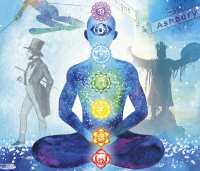
The best way to view the palm is a window into the workings of the brain. In terms of anthropological development, there’s a clearly established link between the way the human hand has become increasingly sophisticated and the way the human brain has evolved. A massive amount of the cerebral cortex is devoted to the palms. In proportion to the amount of brain surface area given to, for example, the knees, the palm’s cortex area is for a pair of organs each around four square feet in size!
Palm size
A word about palm size. Some people have disproportionately
bigger or smaller palms than average in relation to body size. An
easy way to check this is by comparing someone’s hand to the
size of their face. When the base of the palm is lined up with the
chin, the fingertips should rest around the mid-forehead level.
Large hands
People with large palms are plodders. They take things slowly,
they’re pedantic, deliberate and like life on a small scale. Big
hands are great with tiny details and they often work in fields
that require meticulous care where the focus is on getting things
just right: jewellery makers, dental technicians, classical
musicians, painting restorers, research scientists. They can often miss the bigger picture as they’re so absorbed in the painstakingly miniscule.
Small hands
Those with small palms are unconcerned with details and have no time for the minutiae of life. They always see the bigger picture and are firmly focused on the road ahead. Small handed people are impatient and love to balance lots of plans and projects at once, rushing to deal with things head-on. Small palms are suited to working in busy environments and in taking the initiative, but they’ll always need someone to clear up and dot the ‘i’s’ behind them!
Short fingers
If they’re short, the person’s mental processes will be short and
holistic. They like to be realistic, relative, and they calculate
quickly with little time for details. They’re multi-taskers with a
‘hands on’ approach. Check out
the finger length of anyone that
makes quick decisions - one of
life’s doers, you’ll find they have
short fingers.
The exception to this is when
the digits have enlarged joints
and are knotty. Knots tend to
slow down and re-circulate the
thought process. If someone’s
fingers have pronounced knots
The Shape of things to come they’ll be argumentative, pedantic and exacting. It makes for
logical, detailed and thorough mental processes. Pronounced
knots make it hard to be spontaneous.
Long fingers
Long-fingered people have long thoughts, they dwell on things
mentally and take a long view. Long-fingered folk tend to be
specialists, they like to think things over and have a good eye for
detail. Look at the fingers of a classical musician or a researcher.
Long-fingered people refine and assess information before they
act.
Palmistry has traditionally been blighted by superstition and hocus-pocus. It's been impossible to learn the art from a long list of signs, markings and squiggles to remember. Until now that is. Here's a simple, commonsense guide that works. You can start palm reading after a few hours of study with this book. Using the modern language of psychology, rational observation and common sense, you'll be amazed at how much you can see in your own or anyone's palm. Try it - it works!
BUY NOW
READ NEXT
Is your child seeing ghosts?
Is this the most haunted house in the UK?
Categories:
0 comments on this article















